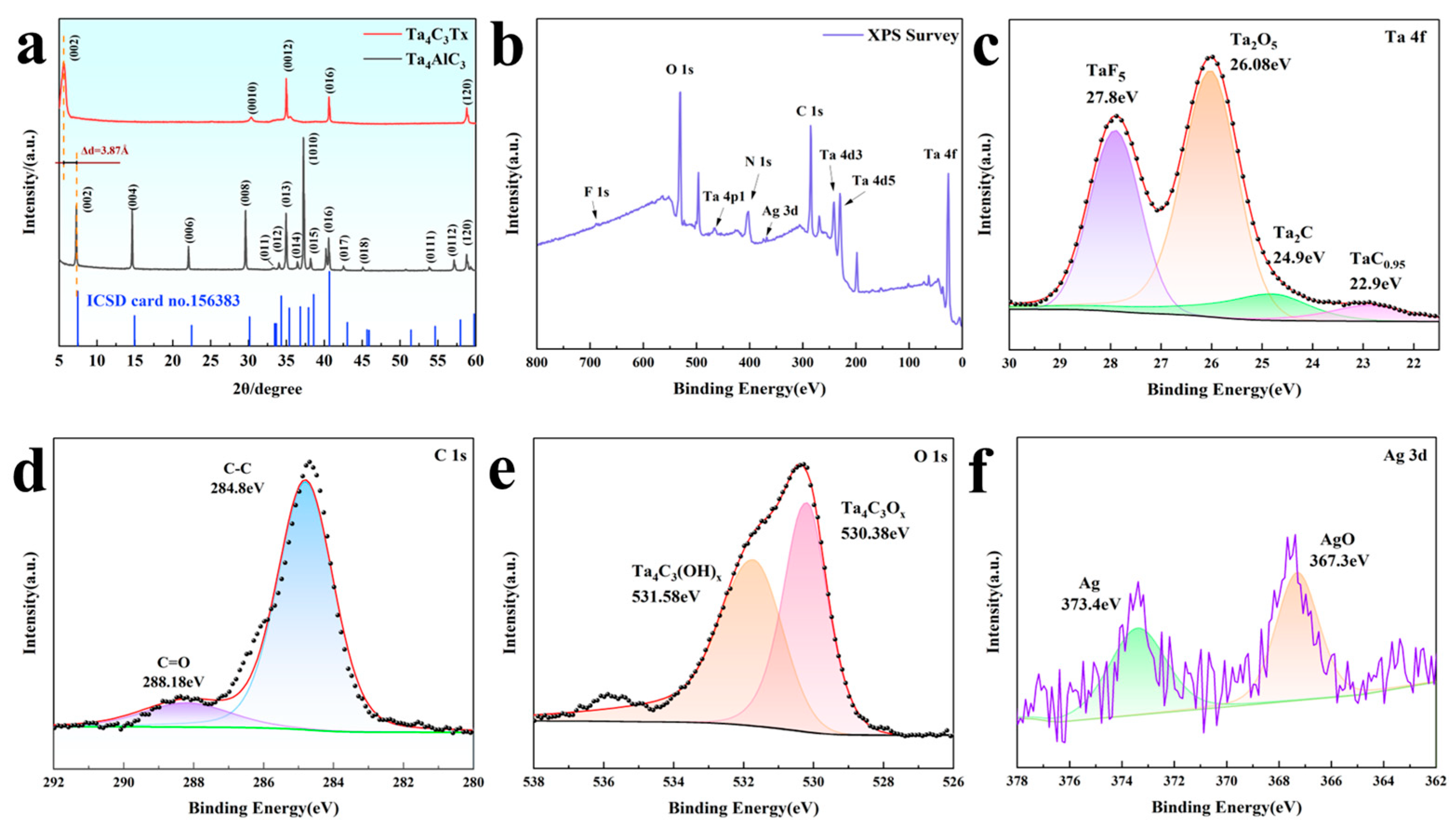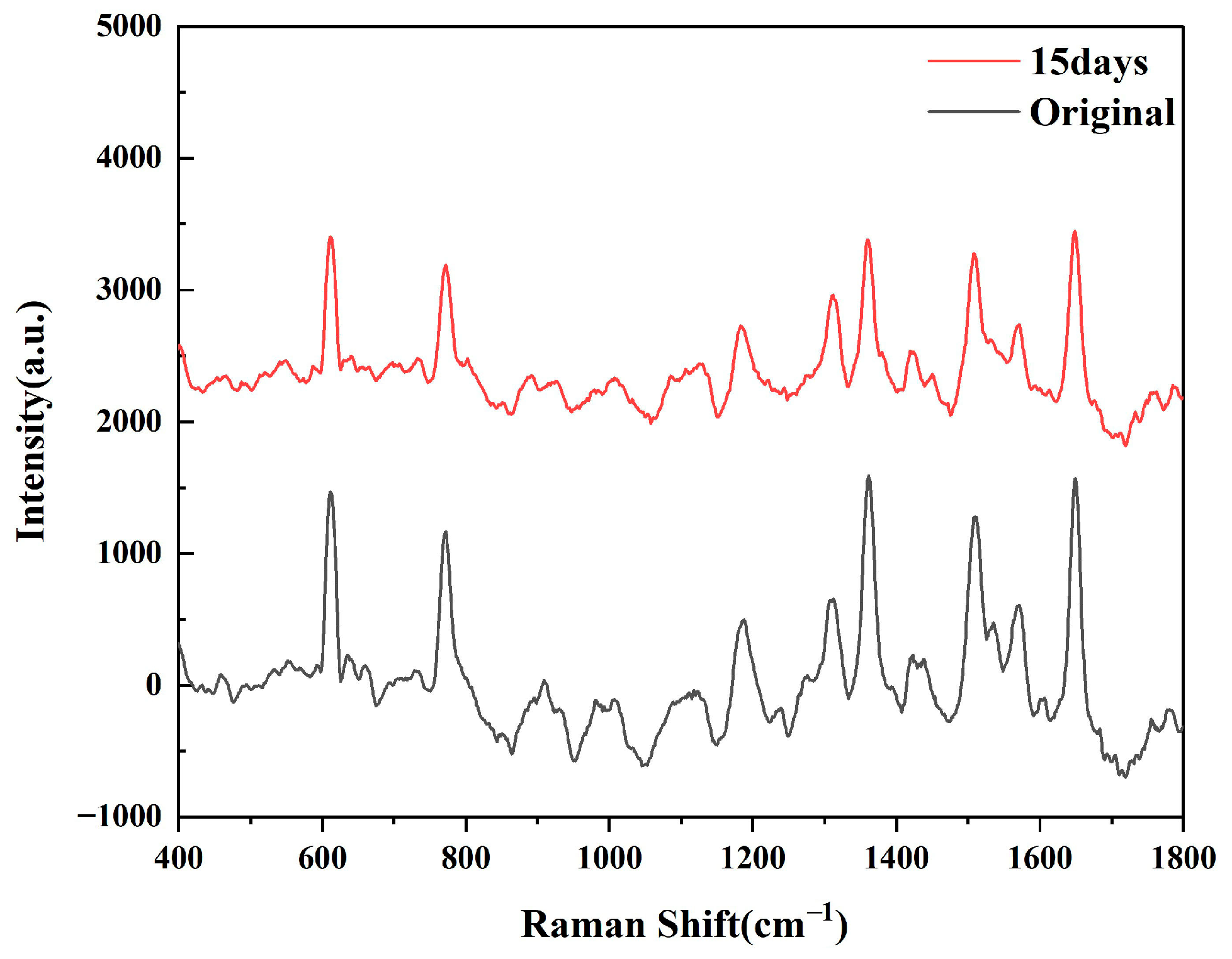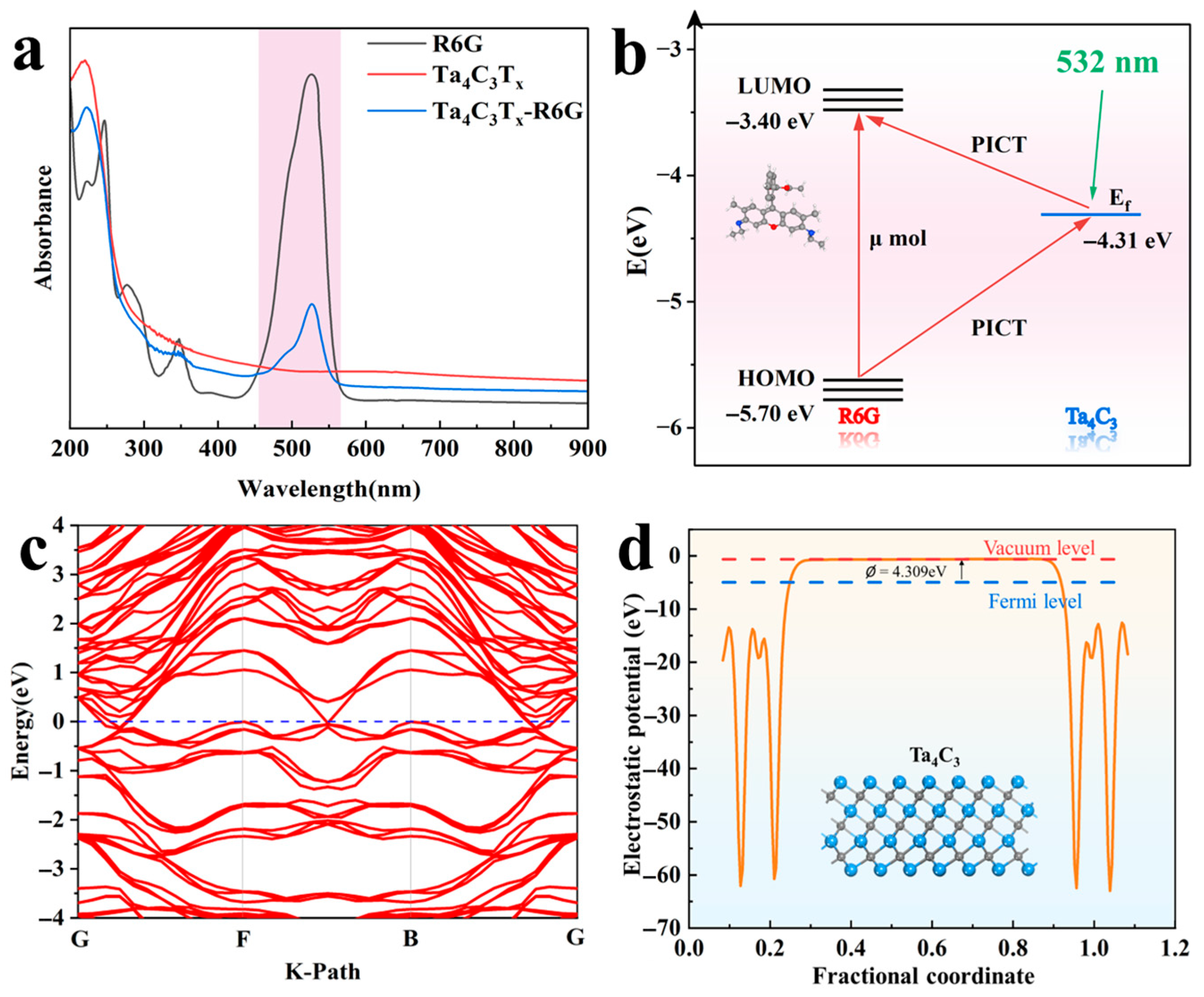A SERS Sensor Prepared via Electrostatic Self-Assembly of Ta4C3@AgNP Nanocomposites for Detection of Ziram
Abstract
1. Introduction
2. Materials and Methods
2.1. Materials
2.2. Preparation of AgNPs
2.3. Synthesis of Ta4C3@AgNP Nanocomposites
2.4. Characterization
2.5. UV-Vis Measurements
2.6. Raman Measurements
3. Results
3.1. Characterization of Ta4C3@AgNP Nanocomposites
3.2. SERS Performance of Ta4C3@AgNP Nanocomposites
3.3. Detection of Ziram Using Ta4C3@AgNP Nanocomposite Sensor
4. Conclusions
Author Contributions
Funding
Data Availability Statement
Conflicts of Interest
References
- Biswas, S.; Alegaonkar, P.S. MXene: Evolutions in Chemical Synthesis and Recent Advances in Applications. Surfaces 2022, 5, 1–34. [Google Scholar] [CrossRef]
- Ampong, D.N.; Agyekum, E.; Agyemang, F.O.; Mensah-Darkwa, K.; Andrews, A.; Kumar, A.; Gupta, R.K. MXene: Fundamentals to Applications in Electrochemical Energy Storage. Discov. Nano 2023, 18, 3. [Google Scholar] [CrossRef] [PubMed]
- Wang, C.; Chen, S.; Song, L. Tuning 2D MXenes by Surface Controlling and Interlayer Engineering: Methods, Properties, and Synchrotron Radiation Characterizations. Adv. Funct. Mater. 2020, 30, 2000869. [Google Scholar] [CrossRef]
- Wang, Y.; Wang, Y.; Jian, M.; Jiang, Q.; Li, X. MXene Key Composites: A New Arena for Gas Sensors. Nano-Micro Lett. 2024, 16, 209. [Google Scholar] [CrossRef] [PubMed]
- Ronchi, R.M.; Arantes, J.T.; Santos, S.F. Synthesis, Structure, Properties and Applications of MXenes: Current Status and Perspectives. Ceram. Int. 2019, 45, 18167–18188. [Google Scholar] [CrossRef]
- Rahman, U.U.; Humayun, M.; Ghani, U.; Usman, M.; Ullah, H.; Khan, A.; El-Metwaly, N.M.; Khan, A. MXenes as Emerging Materials: Synthesis, Properties, and Applications. Molecules 2022, 27, 4909. [Google Scholar] [CrossRef]
- Saxena, S.; Johnson, M.; Dixit, F.; Zimmermann, K.; Chaudhuri, S.; Kaka, F.; Kandasubramanian, B. Thinking Green with 2-D and 3-D MXenes: Environment Friendly Synthesis and Industrial Scale Applications and Global Impact. Renew. Sustain. Energy Rev. 2023, 178, 113238. [Google Scholar] [CrossRef]
- Luo, W.; Xiong, W.; Han, Y.; Yan, X.; Mai, L. Application of Two-Dimensional Layered Materials in Surface-Enhanced Raman Spectroscopy (SERS). Phys. Chem. Chem. Phys. 2022, 24, 26398–26412. [Google Scholar] [CrossRef]
- Liu, Z.-W.; Wang, G.; Li, Y.-F.; Yu, Y. Substrate Types and Applications of MXene for Surface-Enhanced Raman Spectroscopy. Front. Chem. 2024, 12, 1378985. [Google Scholar] [CrossRef]
- Sarycheva, A.; Makaryan, T.; Maleski, K.; Satheeshkumar, E.; Melikyan, A.; Minassian, H.; Yoshimura, M.; Gogotsi, Y. Charge-transfer-driven ultrasensitive (MXene) as Surface-Enhanced Raman Scattering Substrate. J. Phys. Chem. C 2017, 121, 19983–19988. [Google Scholar] [CrossRef]
- Peng, Y.; Lin, C.; Long, L.; Masaki, T.; Tang, M.; Yang, L.; Liu, J.; Huang, Z.; Li, Z.; Luo, X. Charge-Transfer Resonance and Electromagnetic Enhancement Synergistically Enabling MXenes with Excellent SERS Sensitivity for SARS-CoV-2 S Protein Detection. Nano-Micro Lett. 2021, 13, 52. [Google Scholar] [CrossRef] [PubMed]
- Lan, L.; Fan, X.; Yu, S.; Gao, J.; Zhao, C.; Hao, Q.; Qiu, T. Flexible Two-Dimensional Vanadium Carbide MXene-Based Membranes with Ultra-Rapid Molecular Enrichment for Surface-Enhanced Raman Scattering. ACS Appl. Mater. Interfaces 2022, 14, 40427–40436. [Google Scholar] [CrossRef]
- Shein, I.R.; Ivanovskii, A.L. Planar nano-block structures Tin+1Al0.5Cn and Tin+1Cn(n = 1, and 2) from MAX phases: Structural, electronic properties and relative stability from first principles calculations. Superlattices Microstruct. 2012, 52, 147–157. [Google Scholar] [CrossRef]
- Lan, L.; Zhao, C.; Tang, X.; Gao, J.; Li, G.; Cai, H.; Yang, S.; Liu, J.; Qu, Z.; Fan, X. Charge-Transfer-Driven Ultrasensitive SERS Sensing in a Two-Dimensional Titanium Carbonitride MXene. Opt. Lett. 2024, 49, 2405–2408. [Google Scholar] [CrossRef]
- Lan, L.; Ni, Z.; Zhao, C.; Gao, J.; Tang, X.; Qu, Z.; Zheng, L.; Fan, X.; Qiu, T. Photoinduced Charge Transfer Empowers Ta4C3 and Nb4C3 MXenes with High SERS Performance. Langmuir 2024, 40, 20945–20953. [Google Scholar] [CrossRef]
- Lee, P.C.; Meisel, D. Adsorption and Surface-Enhanced Raman of Dyes on Silver and Gold Sols. J. Phys. Chem. 1982, 86, 3391–3395. [Google Scholar] [CrossRef]
- Syamsai, R.; Grace, A.N. Ta4C3 MXene as Supercapacitor Electrodes. J. Alloys Compd. 2019, 792, 1230–1238. [Google Scholar] [CrossRef]
- Naguib, M.; Mashtalir, O.; Carle, J.; Presser, V.; Lu, J.; Hultman, L.; Gogotsi, Y.; Barsoum, M.W. Two-Dimensional Transition Metal Carbides. ACS Nano 2012, 6, 1322–1331. [Google Scholar] [CrossRef]
- Chen, Y.; Jiang, C.; Huang, F.; Yu, Z.; Jiang, L. Efficient Interfacial Self-Assembled MXene/Ag NPs Film Nanocarriers for SERS-Traceable Drug Delivery. Anal. Bioanal. Chem. 2023, 415, 5379–5389. [Google Scholar] [CrossRef]
- Meng, W.U.; Lei, R.; Zhang, J.F.; Li, Y.X.; Ji, Z.Y.; Ying, G.B. Research Progress in Preparation and Performance of MXene and Its Composite Absorbing Materials. Acta Mater. Compos. Sin 2022, 39, 942–955. [Google Scholar] [CrossRef]
- Du, B.; Zhao, Y.; Ren, Z.; Liu, Q.; Zhang, F. 2D Ta4AlC3 and Ta4C3 nanosheets with excellent ultraviolet optical limiting behavior for laser protection. J. Mater. Chem. C 2024, 12, 7748–7758. [Google Scholar] [CrossRef]
- Naguib, M.; Mochalin, V.N.; Barsoum, M.W.; Gogoysi, Y. 25th Anniversary Article: MXenes: A New Familyof Two-Dimensional Materials. Adv. Mater. 2014, 26, 992–1005. [Google Scholar] [CrossRef]
- Lin, H.; Wang, Y.; Gao, S.; Chen, Y.; Shi, J. Theranostic 2D Tantalum Carbide (MXene). Adv. Mater. 2018, 30, 1703284. [Google Scholar] [CrossRef]
- Echols, I.J.; Holta, D.E.; Kotasthane, V.S.; Tan, Z.; Radovic, M.; Lutkenhaus, J.L.; Green, M.J. Oxidative Stability of Nbn+1CnTZ MXenes. J. Phys. Chem. C 2021, 125, 13990–13996. [Google Scholar] [CrossRef]
- Yang, Z.; Guo, S.; Park, E.; Sun, Y.; Liu, Y.; Chen, L.; Jung, Y.M. Decoration of Ag nanoparticle on MXene sheets for SERS studies. Spectrochim. Acta Part A Mol. Biomol. Spectrosc. 2024, 316, 124382. [Google Scholar] [CrossRef]
- Hildebrandt, P.; Stockburger, M. Surface-Enhanced Resonance Raman Spectroscopy of Rhodamine 6G Adsorbed on Colloidal Silver. J. Phys. Chem. 1984, 88, 5935–5944. [Google Scholar] [CrossRef]
- Zhang, C.; Jiang, S.Z.; Huo, Y.Y.; Liu, A.H.; Xu, S.C.; Liu, X.Y.; Sun, Z.C.; Xu, Y.Y.; Li, Z.; Man, B.Y. SERS Detection of R6G Based on a Novel Graphene Oxide/Silver Nanoparticles/Silicon Pyramid Arrays Structure. Opt. Express 2015, 23, 24811–24821. [Google Scholar] [CrossRef]
- Lombardi, J.R. The Theory of Surface-Enhanced Raman Scattering on Semiconductor Nanoparticles; toward the Optimization of SERS Sensors. Faraday Discuss. 2017, 205, 105–120. [Google Scholar] [CrossRef]
- Wang, T.; Zhu, C.; Dong, P. Preparation and Application of Two-Dimensional Ta4C3 MXene/Gold Nanostar Composite SERS Substrates for Thiram Detection. Langmuir 2024, 40, 22015–22026. [Google Scholar] [CrossRef]
- Satheeshkumar, E.; Makaryan, T.; Melikyan, A.; Minassian, H.; Gogotsi, Y.; Yoshimura, M. One-step solution processing of Ag, Au and Pd@MXene hybrids for SERS. Sci. Rep. 2016, 6, 32049. [Google Scholar] [CrossRef]
- Liu, G.H.; Wang, H.F.; Xu, C.Y.; Fang, Q.L.; Wang, H.L.; Xu, Y.Q.; Sang, M.; Xuan, S.H.; Hao, L.Y. A MXene@AgAu@PDA nanoplatform loaded with AgAu nanocages for enhancing catalytic activity and antibacterial performance. J. Mater. Chem. B 2023, 11, 10678–10691. [Google Scholar] [CrossRef]
- Wang, C.C.; Han, J.S.; Xue, D.N.; Gu, C.J.; Zeng, S.W.; Jiang, J.H.; Jiang, T.; Li, X.; Ku, K.R. SERS-active immunoassay kit for SARS-CoV-2 mediated by the cooperative chemical and electromagnetic effects of MXene modified with gold nanowires. Spectrochim. Acta Part A Mol. Biomol. Spectrosc. 2024, 305, 123445. [Google Scholar] [CrossRef]
- Park, J.; Kim, J.; Kim, K.; Kim, J.; You, J.; Kim, D.W. Highly sensitive thin SERS substrate by sandwich nanoarchitecture using multiscale nanomaterials for pesticide detection on curved surface of fruit. J. Hazard. Mater. 2025, 494, 138450. [Google Scholar] [CrossRef]
- Fernandes, T.; Fateixa, T.; Ferro, M.; Nogueira, H.I.S.; Daniel, A.L.; Trindade, T. Colloidal dendritic nanostructures of gold and silver for SERS analysis of water pollutants. J. Mol. Liq. 2021, 337, 116608. [Google Scholar] [CrossRef]
- Hussain, N.; Li, Y.; Qu, C.; Li, N.; Liu, H. Bimetallic Coreshell Nanorods with Thioglycolic Acid Monolayer for Highly Sensitive and Rapid SERS Detection of Thiabendazole and Ziram Residues in Prunus Persica Peaches. Food Chem. 2025, 464, 141688. [Google Scholar] [CrossRef]
- GB2763-2021; National Health Commission of the People’s Republic of China, Ministry of Agriculture and Rural Affairs of the People’s Republic of China, State Administration for Market Regulation: National food Safety Standard-Maximum Residue Limits for Pesticides in Food. China Agriculture Press: Beijing, China, 2021; p. 496.







| SERS Spectrum (cm−1) | Assignment |
|---|---|
| 430 | C=S vibration mode |
| 563 | Vibration mode of S=S |
| 933 | C=S vibration mode |
| 1141 | CH3 deformation and CN stretching |
| 1378 | CN stretching and CH3 rocking |
Disclaimer/Publisher’s Note: The statements, opinions and data contained in all publications are solely those of the individual author(s) and contributor(s) and not of MDPI and/or the editor(s). MDPI and/or the editor(s) disclaim responsibility for any injury to people or property resulting from any ideas, methods, instructions or products referred to in the content. |
© 2025 by the authors. Licensee MDPI, Basel, Switzerland. This article is an open access article distributed under the terms and conditions of the Creative Commons Attribution (CC BY) license (https://creativecommons.org/licenses/by/4.0/).
Share and Cite
Hua, K.; Li, L.; Liang, P. A SERS Sensor Prepared via Electrostatic Self-Assembly of Ta4C3@AgNP Nanocomposites for Detection of Ziram. Biosensors 2025, 15, 426. https://doi.org/10.3390/bios15070426
Hua K, Li L, Liang P. A SERS Sensor Prepared via Electrostatic Self-Assembly of Ta4C3@AgNP Nanocomposites for Detection of Ziram. Biosensors. 2025; 15(7):426. https://doi.org/10.3390/bios15070426
Chicago/Turabian StyleHua, Kai, Liang Li, and Pei Liang. 2025. "A SERS Sensor Prepared via Electrostatic Self-Assembly of Ta4C3@AgNP Nanocomposites for Detection of Ziram" Biosensors 15, no. 7: 426. https://doi.org/10.3390/bios15070426
APA StyleHua, K., Li, L., & Liang, P. (2025). A SERS Sensor Prepared via Electrostatic Self-Assembly of Ta4C3@AgNP Nanocomposites for Detection of Ziram. Biosensors, 15(7), 426. https://doi.org/10.3390/bios15070426






